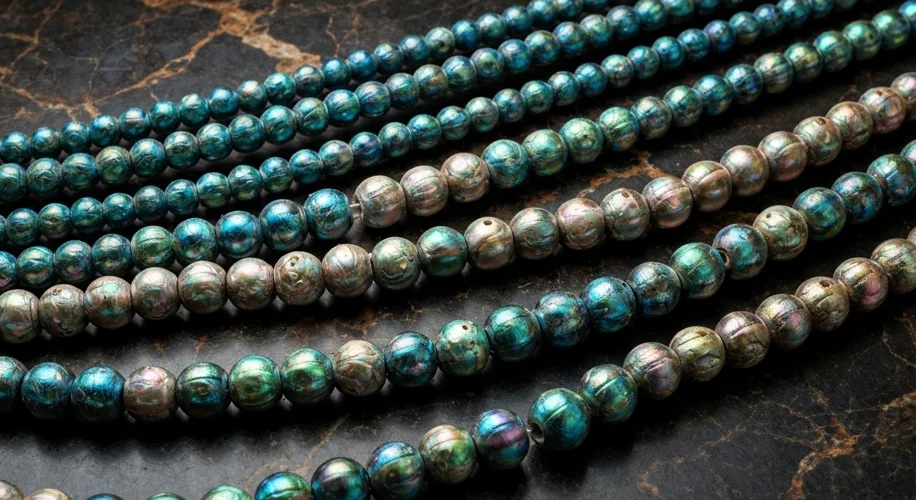The glint of gold, the cool kiss of a polished stone against skin – for millennia, humans have adorned themselves with jewelry. Far more than mere decoration, these crafted objects have woven themselves into the very fabric of civilization, serving as potent symbols of power, faith, and identity. From the earliest sparks of human creativity, the desire to embellish and to imbue objects with meaning has driven the creation of adornments that tell stories stretching back to the dawn of time.
The story of jewelry is, in many ways, the story of humanity’s burgeoning consciousness and its drive to express more than the purely functional. Consider the iridescent shell beads found in a cave in present-day Israel, dating back an astonishing 100,000 years. These weren’t merely pretty objects; they represent a profound leap in cognitive ability, a capacity for symbolic thought. The wear patterns suggest they were strung and worn, perhaps as a testament to social status, spiritual belief, or simply a connection to something beautiful beyond the immediate needs of survival.

As civilizations began to flourish, so too did the art of adornment. In ancient Mesopotamia, around 3000 BCE, elaborate necklaces and bracelets crafted from gold, lapis lazuli, and carnelian became markers of royalty and high status. The Sumerians, in particular, were masters of goldsmithing, creating intricate pieces that reflected their sophisticated culture and burgeoning trade networks. These weren’t just pretty baubles; they were tangible representations of wealth, power, and divine favor. A Sumerian queen, bedecked in golden headdresses and intricate beadwork, projected an image of authority that transcended mere physical presence.
Across the globe, similar narratives unfolded. In ancient Egypt, jewelry was deeply entwined with religious beliefs and the afterlife. The intricate pectoral necklaces worn by pharaohs and nobles, often featuring scarab beetles (symbols of rebirth), the Eye of Horus, or deities like Ra, were believed to offer protection in both life and death. Gold, considered the flesh of the gods, was paramount, often combined with vibrant stones like turquoise and lapis lazuli. The golden funerary mask of Tutankhamun, perhaps the most famous example, is a breathtaking testament to the Egyptians’ belief in the power of adornment to guide and protect the deceased into eternity.
The Bronze Age saw the spread of sophisticated metalworking techniques, allowing for more complex and widespread use of jewelry. In Europe, during this period, torcs – rigid neck rings made of twisted metal – became symbols of status and power among Celtic chieftains. These imposing ornaments, often crafted from gold or bronze, not only signified wealth but also served as a visual declaration of leadership on the battlefield. The sheer weight and craftsmanship of a well-made torc would have immediately set its wearer apart.
Even as empires rose and fell, the fundamental significance of jewelry persisted. In the Roman Empire, while personal adornment was common across social strata, certain materials and styles clearly demarcated rank and office. Senators might wear rings of iron or gold, while the wealthy elite flaunted elaborate necklaces and armbands adorned with precious gems. Jewelry also played a role in religious rituals and even military regalia, a constant thread connecting the personal to the public, the sacred to the secular.
The Byzantine Empire, the heir to Rome’s eastern legacy, elevated jewelry to an art form and a critical component of imperial symbolism. The emperor’s regalia, dripping with pearls, emeralds, and gold, was not merely for show; it was a divine mandate made visible. Enameling techniques reached new heights, creating dazzling mosaics of color on precious metals. These elaborate pieces communicated the emperor’s divine right to rule, his immense wealth, and his connection to the celestial realm. Wearing a specific jeweled cross or brooch could signify allegiance, rank, or a particular spiritual devotion.
The enduring power of jewelry lies in its multifaceted nature. It is a canvas for artistic expression, a declaration of social standing, a tool for spiritual connection, and a personal talisman against the uncertainties of life. From the humble shell beads of our earliest ancestors to the dazzling regalia of emperors, jewelry has always been more than just adornment; it has been a fundamental part of the human story, reflecting our deepest desires, our loftiest aspirations, and our enduring need to leave a mark upon the world.
These glittering artifacts, unearthed from the dust of ages, continue to speak to us, whispering tales of who we were and, in a way, reminding us of who we are.

